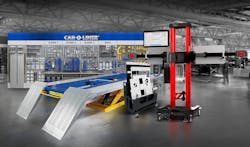Taking the Guesswork Out of ADAS Calibrations
As the industry continues to advance and move toward autonomous vehicles, proper calibration is more important than ever. Ensuring that your vehicle is correctly calibrated back to its pre-crash state is crucial to keeping your customers safe on the road.
FenderBender spoke with Christopher Sobieski, North American ADAS Special Projects Manager at Snap-on Equipment, to learn about the role of ADAS calibration in collision repair facilities.
“Every manufacturer requires calibrations to be performed after repairs to the vehicle. It could be something as simple as just the windshield replacement, or any part of collision damage that needs to be repaired the proper way. Vehicles need to be placed back into what we refer to as a ready-to-crash state,” said Sobieski. “Cars are built and designed to withstand a collision and protect the occupants. When a car goes back into the collision shop, not only is the cosmetic part of the job being done but also the recalibration of systems so that they all work just as they did before.”
Unfortunately, there is widespread misinformation about ADAS calibration throughout the collision repair industry, and many calibrations are either being missed or are improperly performed.
"The biggest thing that collision repairers need to understand is WHEN the calibration needs to be done," Sobieski said. “In a collision shop, about four out of every 10 cars that come through have some calibration that needs to be performed there [Source: CCC Intelligent Solutions]. Unfortunately, we're seeing less than 25 percent of those vehicles getting calibrated [Source: Insurance Institute for Highway Safety]. That also leads to customers coming back, because their vehicle doesn't react, behave and perform the way it did before the collision.”
Also, many collision repair facilities are not following OEM repair procedures when it comes to calibrations, as there are very specific parameters that must be followed exactly without deviation to ensure a successful calibration.
ADAS Calibration Made Easy
Tru-Point™ by John Bean® reduces the work involved in manual calibrations by using advanced technology to scan the vehicle, automatically place targets, and complete the calibration without the need for a level floor or tape measure. Tru-Point™ is able to match or exceed OEM requirements, ensuring that your calibrations are precise and accurate.
While this technology might seem intimidating if you are used to performing manual calibrations, John Bean® is ready to provide the equipment setup and all of the training for your technicians to ensure a seamless transition.
As vehicle technology continues to advance and systems requiring calibrations become even more complicated, the accuracy of manual calibrations will continue to decline, while the time required to perform precision calibrations will increase. Transitioning right now to an automated calibration system puts you ahead of the curve, saving your shop valuable time and money in the long run.
For more information regarding Tru-Point™, visit https://www.johnbean.com/us/.


